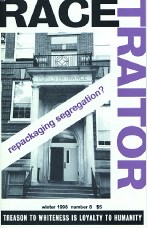This excerpt from When Race Becomes Real: Black and White Writers Confront Their Personal Histories, edited by Bernestine Singley, appeared in 2002 as part of Harvard Magazine’s coverage of recent books by Harvard affiliates. The excerpt concerns author Noel Ignatiev’s role in launching a journal “to chronicle and analyze the making, remaking, and unmaking of whiteness.”
"The good news is that there are now a host of writers and a growing number of courses and workshops designed to enlighten white people as to the real benefits and the great cost of their property in whiteness," writes former Harvard Law School professor Derrick Bell in his epilogue to When Race Becomes Real: Black and White Writers Confront Their Personal Histories, edited by Bernestine Singley, LL.M. '76 (Lawrence Hill Books, $26.95). Many of those engaged in this Herculean task are white, Bell notes, among them Noel Ignatiev, Ed.M. '85, Ph.D. '94, C.A.S. '95, author of How the Irish Became White and a fellow at the W.E.B. Du Bois Institute, who writes:
In the interests of survival, Afro-Americans have always studied whiteness. There is a long tradition among them that the white race is a peculiar sort of social formation, one that depends on its members' willingness to conform to the institutions and behavior patterns that reproduce it. By the early 1900s...it was becoming commonplace in the academy to speak of race, along with class and gender, as a social construct....
In addition to the notion of race as a social construct, [an old friend, John Garvey, and I] shared another, which we owed to the West Indian Marxist C.L.R. James: that ordinary Americans are drawn by the conditions of their lives in two opposite directions, one that mirrors and reproduces the present society of competition and exploitation, and another that points toward a new society based on freely associated activity. We believed that this internal antagonism played itself out as a civil war within the white mind, between the desire of whites to wall themselves off from black Americans and their desire to overcome the boundaries that kept them apart.

John and I decided that it was time to launch a journal to document that civil war. The result was Race Traitor, whose first issue appeared in the fall of 1992 with the slogan "Treason to whiteness is loyalty to humanity" on its cover. The aim was to chronicle and analyze the making, remaking, and unmaking of whiteness. My book on the Irish was the story of how people for whom whiteness had no meaning learned its rules and adapted their behavior to take advantage of them; Race Traitor was an attempt to run the film backwards, to explore how people who had been brought up as white might become unwhite....
The goal of abolishing the white race is on its face so desirable that some may find it hard to believe that it could incur any opposition other than from committed white supremacists. Of course we expected bewilderment from people who still think of race as biology. We frequently get letters accusing us of being "racists," just like the KKK, and have even been called a "hate group." ...
Our standard response is to draw an analogy with anti-royalism: to oppose monarchy does not mean killing the king; it means getting rid of crowns, thrones, royal titles, etc....
Every group within white America has at one time or another advanced its particular and narrowly defined interests at the expense of black people as a race. That applies to labor unionists, ethnic groups, college students, schoolteachers, taxpayers, and white women. Race Traitor will not abandon its focus on whiteness, no matter how vehement the pleas and how virtuously oppressed those doing the pleading. The editors meant it when they replied to a reader, "Make no mistake about it: we intend to keep bashing the dead white males, and the live ones, and the females too, until the social construct known as 'the white race' is destroyed—not 'deconstructed' but destroyed."








